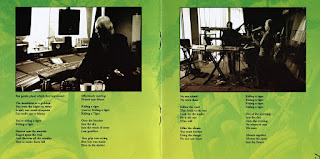Fly from Here is the twentieth studio album from the English rock band Yes, released on 22 June 2011 in France and Japan on Frontiers Records and Avalon, respectively, 1 July in Europe and Australia, and 12 July in the United States. Their first studio album in ten years, it is the only one recorded with singer Benoît David in the band's line-up following the departure of Jon Anderson in 2008. Former Yes singer and producer Trevor Horn returned to produce the album. Its highlight is the 24-minute "Fly from Here" suite, a track originally written by Horn and former Yes keyboardist Geoff Downes prior to them joining Yes in 1980.
Fly from Here received positive reviews from critics and peaked at No. 30 on the UK Albums Chart and No. 36 on the U.S. Billboard 200. During the recording of the album, Downes replaced keyboardist Oliver Wakeman thus becoming a full-time member for the first time since 1981, and David was replaced by Jon Davison after contracting respiratory illness, during the album's subsequent tour.
Fly from Here is the band's first studio album in ten years following Magnification (2001), the longest gap between two Yes albums. In 2008, while plans for a concert tour were taking shape, singer Jon Anderson required some time off after he suffered from a severe asthma attack. Rather than wait for Anderson to recover, remaining members Chris Squire, Steve Howe, and Alan White opted to tour, recruiting Canadian singer Benoît David in the process after Squire was introduced to him through a YouTube video with David singing in Close to the Edge, a Canadian Yes tribute band, which he was a member of over ten years. Yes resumed touring in November 2008, performing concerts worldwide with Oliver Wakeman, son of former Yes keyboardist Rick Wakeman, after his father was advised not to tour by his doctor.
In 2010, work began on developing new material for Fly from Here. To help with the writing process and production, the band recruited former Yes singer and producer Trevor Horn, who sang and played on Drama (1980). Much of the album drew heavily on two songs which he wrote in 1980 with his Buggles partner, keyboardist Geoff Downes, who also joined Yes with Horn that year. Initially the duo wrote a demo titled "We Can Fly from Here", which Yes recorded in the studio and performed live on their 1980 tour of North America and the UK, and even rehearsed it for a short while with former Yes drummer Bill Bruford replacing an injured White. When Yes disbanded in 1981, Horn and Downes recorded another demo of "We Can Fly from Here", this time as a two-part song that was released as a bonus track on the 2010 reissue of the second Buggles album, Adventures in Modern Recording (1981). "Fly from Here" was reworked into a 24-minute, six-part suite.
These two demos and a third unreleased recording formed the basis of "We Can Fly", "Sad Night at the Airfield", and "Madman at the Screens" from the Fly from Here suite. A further Buggles demo, "Riding a Tide", released on the 2010 reissue of Adventures in Modern Recording, was reworked into "Life on a Film Set". Further contributions to the "Fly From Here" suite were made by Squire and Howe, who contributed the two-minute instrumental "Bumpy Ride", "Hour of Need", and "Solitaire", while the group co-wrote "Into the Storm" with Horn. "The Man You Always Wanted Me to Be" was co-written by Squire with friends Gerard Johnson and Simon Sessler.
The first recording session for Fly from Here took place between 3 October–12 November 2010 at SARM West Coast Studios in Los Angeles, California, before they resumed in the first week of January 2011. Horn produced the album using the digital audio workstation software Pro Tools. The album was mixed in April 2011 at SARM West Studios in London, where additional vocals were recorded. During the recording process in 2011, Wakeman was replaced by Downes at Horn's suggestion and with the band's agreement, who reasoned that as a co-writer of the original "Fly from Here" demos, Downes would have a better feel for the album's material than Wakeman.
The cover was designed by artist Roger Dean, who has created many of the group's previous album covers. It is a painting he started in 1970 but had remained uncompleted. He finished it in the style of his current works, but the colour and texture were kept from the original.

















No hay comentarios.:
Publicar un comentario